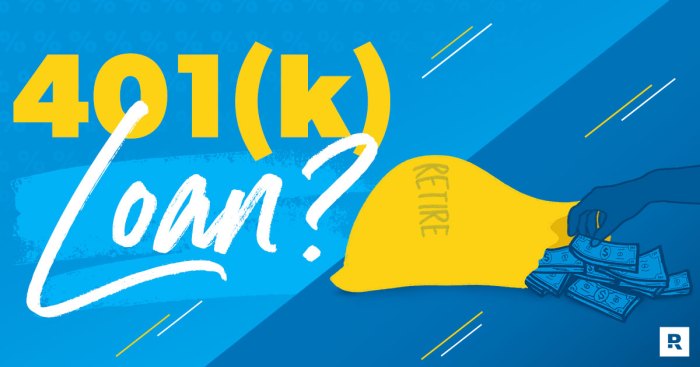
The crushing weight of student loan debt is a reality for millions, often forcing difficult financial choices. One such choice, fraught with potential pitfalls and long-term consequences, is tapping into your 401(k) retirement savings to alleviate the burden. This guide explores the complexities of using your 401k to pay student loans, weighing the immediate relief against the potential sacrifices to your future financial security.
We’ll delve into the financial implications, including tax penalties, the impact on retirement savings, and a comparison of interest rates. We’ll also examine alternative strategies for managing student loan debt, such as income-driven repayment plans and refinancing, providing a balanced perspective on this critical decision. Ultimately, the goal is to equip you with the information necessary to make an informed and responsible choice.
Financial Implications of Using 401(k) for Student Loans

Accessing your 401(k) to pay off student loans presents a significant financial decision with long-term consequences. While it might offer immediate relief from debt, the potential drawbacks can significantly impact your future financial security. Careful consideration of the associated costs and long-term implications is crucial before making such a choice.
Tax Penalties Associated with Early 401(k) Withdrawal
Withdrawing from a 401(k) before age 59 1/2 typically incurs a 10% early withdrawal penalty, in addition to income taxes on the withdrawn amount. This means a substantial portion of your savings will be lost to penalties and taxes. For example, if you withdraw $10,000, you’ll likely pay $1,000 in penalties and an additional amount in income taxes, depending on your tax bracket. This significantly reduces the actual amount available to pay down your student loans.
Long-Term Impact on Retirement Savings
Withdrawing from your 401(k) reduces your principal and the potential for future growth through compound interest. Compound interest, the interest earned on both the principal and accumulated interest, is a powerful tool for long-term wealth building. By withdrawing funds early, you lose out on years of potential compound growth, potentially leaving you with a significantly smaller retirement nest egg. For instance, withdrawing $20,000 at age 30, which could have grown to potentially $100,000 by retirement age (depending on investment performance), represents a substantial loss in retirement savings.
Comparison of Interest Rates on Student Loans and Potential 401(k) Investment Returns
Student loan interest rates vary but are generally lower than the potential returns of a well-diversified 401(k) investment portfolio over the long term. While specific returns are not guaranteed, historical data shows that the stock market has generated higher average returns than most student loan interest rates. By withdrawing from your 401(k), you’re essentially trading a potentially higher-yielding investment for a lower-yielding debt.
Calculation of Lost Potential Earnings from Early 401(k) Withdrawal
Let’s illustrate the potential loss with a simplified example. Assume a $10,000 withdrawal from a 401(k) with an average annual return of 7%. If this money remained invested for 30 years, the future value, ignoring fees and taxes, could be calculated using the future value formula:
FV = PV (1 + r)^n
Where: FV = Future Value, PV = Present Value ($10,000), r = annual rate of return (0.07), n = number of years (30)
FV = $10,000 (1 + 0.07)^30 ≈ $76,123
This calculation demonstrates that a $10,000 withdrawal today could potentially grow to approximately $76,123 over 30 years. This is a significant loss if the funds are withdrawn early.
Comparison of Loan Repayment Strategies
| Strategy | Pros | Cons | Long-Term Impact |
|---|---|---|---|
| Standard Repayment | Predictable payments, lower interest paid over time | Longer repayment period | Moderate impact on long-term finances |
| Income-Driven Repayment | Lower monthly payments based on income | Potentially higher interest paid over time, longer repayment period | Moderate to significant impact depending on income and interest |
| Refinancing | Potentially lower interest rate, shorter repayment period | Requires creditworthiness | Positive impact on long-term finances |
| 401(k) Withdrawal | Immediate debt reduction | High tax penalties, significant loss of retirement savings | Highly negative impact on long-term financial security |
Alternative Strategies for Managing Student Loan Debt

Managing student loan debt effectively requires exploring various options beyond the potentially risky strategy of using 401(k) funds. Several alternative approaches can help borrowers reduce their debt burden and improve their financial well-being. These strategies offer different levels of complexity and require careful consideration of individual circumstances.
Income-Driven Repayment Plans
Income-driven repayment (IDR) plans adjust your monthly student loan payments based on your income and family size. This can significantly lower your monthly payments, making them more manageable, particularly during periods of lower income. Several IDR plans exist, including the Income-Driven Repayment (IDR), Pay As You Earn (PAYE), Revised Pay As You Earn (REPAYE), and Income-Based Repayment (IBR) plans. The specific plan you qualify for depends on your loan type and income. A key benefit is the potential for loan forgiveness after a set number of qualifying payments, typically 20 or 25 years, depending on the plan. However, a drawback is that the extended repayment period can lead to paying more interest over the life of the loan.
Student Loan Refinancing
Student loan refinancing involves replacing your existing student loans with a new loan from a private lender, often at a lower interest rate. This can potentially save you money on interest payments over the life of the loan. To qualify for refinancing, you’ll generally need a good credit score and a stable income. Before refinancing, carefully compare offers from multiple lenders to secure the best interest rate and terms. A significant benefit is the potential for lower monthly payments and reduced total interest paid. However, refinancing may mean losing access to federal student loan benefits, such as income-driven repayment plans and potential loan forgiveness programs.
Negotiating Lower Interest Rates
While less common, it’s sometimes possible to negotiate a lower interest rate with your student loan lender. This often requires demonstrating financial hardship or making a strong case for a reduced rate. For example, if your credit score has improved significantly since you initially took out the loan, you could use this as leverage. Successfully negotiating a lower interest rate can save you money over time, reducing the total amount you repay. However, lenders are not obligated to negotiate, and success depends on your individual circumstances and the lender’s policies.
Sample Budget for Loan Repayment and Retirement Savings
A balanced budget is crucial for managing student loan debt while still saving for retirement. The following is a sample budget illustrating a potential allocation:
| Category | Percentage of Income |
|---|---|
| Housing | 30% |
| Student Loan Repayment | 15% |
| Food | 15% |
| Transportation | 10% |
| Retirement Savings | 10% |
| Other Expenses | 10% |
This is a sample budget and the percentages may need adjustment based on individual income and expenses. The key is to prioritize both loan repayment and retirement savings to achieve long-term financial security.
Resources for Student Loan Debt Management
Several resources can assist in managing student loan debt. These include:
- The National Foundation for Credit Counseling (NFCC): Offers free and low-cost credit counseling services.
- The Federal Student Aid website (StudentAid.gov): Provides information on federal student loan programs and repayment options.
- Your loan servicer: Can provide information on your specific loan terms and repayment options.
- Nonprofit credit counseling agencies: Can offer personalized guidance and support in managing debt.
These resources offer valuable tools and support for navigating the complexities of student loan repayment. Utilizing these resources can significantly enhance your ability to manage your debt effectively.
Legal and Ethical Considerations
Accessing your 401(k) for non-retirement purposes carries significant legal and ethical implications. While the specific regulations vary by plan and governing legislation (like the Employee Retirement Income Security Act of 1974, or ERISA), early withdrawals generally incur penalties and taxes, impacting your long-term financial security. Ethically, the decision involves weighing immediate needs against future financial well-being.
Early withdrawal from a 401(k) plan is usually subject to a 10% early withdrawal penalty, in addition to your regular income tax liability. This means a significant portion of the withdrawn funds will be lost to penalties and taxes, leaving you with considerably less to apply towards your student loans. Furthermore, you’re losing out on potential investment growth that would have accumulated had the money remained in the account, compounding the financial disadvantage.
Potential Legal Ramifications of 401(k) Access for Non-Retirement Purposes
Accessing 401(k) funds before retirement typically triggers significant tax penalties. The Internal Revenue Service (IRS) levies a 10% early withdrawal penalty on distributions taken before age 59 1/2, unless certain exceptions apply (like severe financial hardship, which may be difficult to prove). Moreover, the withdrawn amount is taxed as ordinary income, potentially pushing you into a higher tax bracket. For instance, withdrawing $20,000 might result in a $2,000 penalty and several thousand more in taxes, leaving you with substantially less than the initial amount. Specific regulations vary depending on the plan provider and the terms Artikeld in the plan documents. Consulting a qualified financial advisor and reviewing your 401(k) plan documents is crucial before making any decisions.
Ethical Considerations of Prioritizing Student Loan Repayment over Retirement Planning
The ethical dilemma lies in balancing immediate debt relief with long-term financial security. Prioritizing student loan repayment over retirement savings can severely jeopardize your financial future. Retirement planning requires consistent contributions over many years to build sufficient funds to support your lifestyle in retirement. Withdrawing from your 401(k) depletes this crucial nest egg, potentially leading to financial hardship in your later years. The ethical responsibility lies in making informed decisions that consider both short-term needs and long-term financial well-being. This involves carefully evaluating all available options and considering the potential consequences of each choice.
Scenarios Justifying and Not Justifying 401(k) Use for Student Loans
Using 401(k) funds for student loans might be justifiable in extreme circumstances, such as facing overwhelming debt with no other viable options and a demonstrable risk of bankruptcy. For example, a scenario where an individual is facing imminent foreclosure or garnishment of wages might warrant considering this option, although it remains a last resort. However, this decision should be carefully weighed against the long-term consequences of depleting retirement savings. Conversely, it is generally not justified when less drastic measures exist, such as income-driven repayment plans, loan consolidation, or refinancing options. Using 401(k) funds for student loans when other feasible and less damaging options are available is financially unwise and ethically questionable. A more prudent approach involves exploring other avenues of debt management before resorting to such drastic measures.
Illustrative Scenarios
Let’s examine scenarios where utilizing 401(k) funds for student loan repayment presents both responsible and irresponsible financial choices. We’ll also explore the long-term consequences of different withdrawal amounts on retirement savings.
Scenario: Financially Responsible 401(k) Withdrawal for Student Loans
Imagine Sarah, a 35-year-old with significant high-interest student loan debt (approximately $100,000 at 7% interest). She has a well-established 401(k) with a modest balance of $50,000. Her current income allows only minimum student loan payments, stretching repayment over two decades. However, Sarah anticipates a substantial salary increase in the next two years, and her 401(k) contributions are already maximizing employer matching. In this instance, strategically withdrawing a portion of her 401(k) to significantly reduce her high-interest debt could be a financially responsible decision. The accelerated debt reduction, combined with her projected income increase, could save her thousands in interest over the long term and potentially outweigh the loss of long-term 401(k) growth.
Scenario: Financially Irresponsible 401(k) Withdrawal for Student Loans
Consider Mark, a 28-year-old with $30,000 in student loan debt at 4% interest. He has a relatively small 401(k) balance of $15,000. He’s just starting his career and hasn’t fully established his savings habits. Withdrawing his entire 401(k) to pay off his student loans would be a financially irresponsible move. The lower interest rate on his loans makes aggressive repayment less critical, and depleting his retirement savings at such an early stage could severely impact his long-term financial security. The potential loss of compound interest on his 401(k) would likely outweigh the modest savings on interest from accelerated loan repayment.
Impact of Different Withdrawal Amounts on Future Retirement Income
Let’s assume a hypothetical 401(k) account with an initial balance of $100,000, earning an average annual return of 7%. We’ll compare scenarios with different withdrawal amounts:
| Withdrawal Amount | Remaining Balance | Projected Balance at Age 65 (30 years) |
|---|---|---|
| $0 | $100,000 | $761,226 |
| $25,000 | $75,000 | $570,919 |
| $50,000 | $50,000 | $380,613 |
*Note: These figures are simplified and do not account for annual contributions, fees, or market fluctuations.* This demonstrates how even moderate withdrawals can significantly impact long-term retirement savings.
Visual Representation of 401(k) Growth with and without Early Withdrawal
Imagine two line graphs charting the growth of a 401(k) over 30 years. The first graph, representing “No Withdrawal,” shows a steadily upward-sloping line, reflecting consistent growth with compounding returns. The line starts at $100,000 and ends at approximately $761,226 (based on the 7% annual return). The second graph, “Withdrawal of $50,000,” starts at $100,000 but immediately drops to $50,000. While it also shows upward growth, the line remains consistently below the “No Withdrawal” line, ending at approximately $380,613 at age 65, highlighting the significant impact of early withdrawal on long-term growth. The difference between the two lines visually represents the lost potential for growth due to the early withdrawal.
Impact on Credit Score and Future Borrowing
Withdrawing from your 401(k) early to pay off student loans can have significant, long-term consequences on your credit score and future borrowing ability. While the 401(k) withdrawal itself doesn’t directly impact your credit score, the financial repercussions stemming from it can. This section details these potential effects.
The primary impact on your credit score is indirect. Early 401(k) withdrawals often lead to increased reliance on other forms of debt, such as personal loans or credit cards, to cover expenses previously managed through retirement savings. Increased debt utilization, the proportion of available credit used, directly impacts credit scores. Higher utilization ratios negatively affect credit scores, potentially lowering your credit rating and making it more difficult to secure future loans at favorable interest rates. Furthermore, if you are unable to repay these new debts, it could lead to delinquencies or defaults, severely damaging your credit history.
Credit Score Impacts from Increased Debt
Taking money from your 401(k) reduces your overall financial stability. This often necessitates borrowing to maintain your lifestyle or meet financial obligations. Increased borrowing, even if managed responsibly initially, increases your debt-to-income ratio (DTI). A high DTI indicates a larger portion of your income is allocated to debt repayment, signaling higher risk to lenders. Lenders use DTI as a crucial factor in assessing loan applications. A higher DTI reduces your chances of loan approval or results in less favorable terms, such as higher interest rates and stricter repayment schedules. For example, someone with a high DTI might find it difficult to secure a mortgage or an auto loan with favorable terms, even if their credit score is otherwise good.
Consequences on Future Borrowing Capacity
The financial instability created by early 401(k) withdrawals can significantly limit future borrowing capacity. Lenders assess not only your credit score but also your overall financial health. Withdrawing from retirement savings demonstrates a potential lack of financial planning and responsible management of resources. This can make lenders hesitant to extend credit, especially for larger loans like mortgages or business loans. Consider a scenario where someone needs a loan to purchase a home. If they have recently withdrawn from their 401(k), lenders might perceive them as a higher risk, leading to loan rejection or less favorable interest rates and loan terms compared to someone with a stable financial history and adequate retirement savings. Furthermore, the loss of potential investment growth within the 401(k) further impacts long-term financial stability and thus borrowing capacity. The compounding effect of lost investment growth over time significantly reduces the available funds for future borrowing needs.
Final Conclusion

Deciding whether to use your 401(k) to pay off student loans is a deeply personal and complex financial decision. While the immediate gratification of debt reduction is tempting, the long-term ramifications for your retirement savings are significant. By carefully weighing the potential benefits against the considerable costs – both financial and personal – and exploring alternative debt management strategies, you can make a choice that aligns with your individual circumstances and long-term financial goals. Remember, seeking professional financial advice is crucial before making such a substantial decision.
Key Questions Answered
What are the tax implications of withdrawing from my 401(k) before retirement?
Early withdrawals from a 401(k) are typically subject to income tax and a 10% early withdrawal penalty unless certain exceptions apply (like hardship withdrawals).
Can I only withdraw a portion of my 401(k)?
Yes, you can usually withdraw a portion of your 401(k) balance, but the tax and penalty implications remain the same for the amount withdrawn.
How will withdrawing from my 401(k) affect my credit score?
Directly, it won’t. However, if the withdrawal leads to financial hardship and missed payments on other debts, your credit score could suffer.
What are the long-term effects on my retirement savings?
Withdrawing from your 401(k) significantly reduces the amount available to grow tax-deferred over time, potentially leading to a substantially smaller retirement nest egg.
